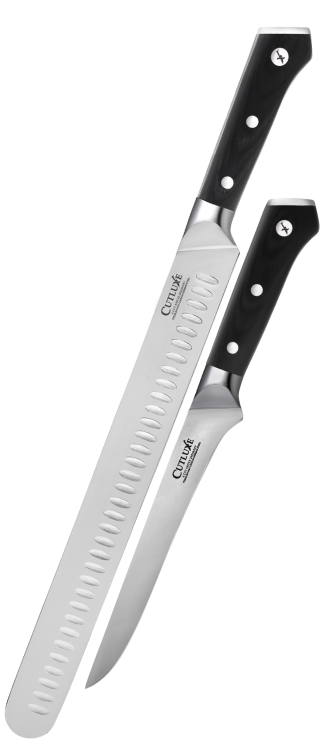How to Slice Brisket Flat for Maximum Tenderness
The brisket flat is the larger, leaner part of the brisket—the one that presents beautifully on a platter. Cutting brisket correctly means slicing across the grain and maintaining consistent thickness. This helps prevent chewiness and ensures every bite of brisket is as tender as possible. Start by trimming any excess fat from the surface of the brisket, leaving just enough to lock in flavor. Use a long, sharp knife and draw it in smooth, single strokes; avoid sawing motions, which can tear the brisket meat.
Even slight variations in beef brisket slice thickness can affect the texture, so aim for uniform, pencil-thick cuts all the way through. Let the brisket rest before slicing to allow the juices to redistribute evenly. This resting step enhances both flavor and moisture in every slice of brisket. Never cut too early, or you risk losing the juices that make the brisket tender.
Identifying the Grain Direction in Brisket
Look for long, parallel muscle fibers running lengthwise across the brisket flat. If they’re hard to see, grab and pull the brisket ends apart, and the fibers stretch out in the grain’s direction. Your goal is to cut perpendicular to those fibers. Doing so shortens the muscle strands in each brisket slice, making the brisket more tender and easier to chew.
Sometimes you’ll need to rotate the meat slightly to maintain a clean cut against the grain. Remember, the grain can sometimes change direction in different parts of the brisket, so adjust your slicing accordingly. Taking the time to identify the grain correctly will elevate the overall texture and enjoyment of your brisket.
Choosing the Right Angle and Thickness for Brisket
Start with the corner of the flat opposite the point. Hold your blade roughly pencil-thick (~2 cm) and slice across the grain at a 90° (or slightly angled) orientation. As you progress through the brisket, aim for uniform slices, sometimes tapering gently. Thin slices ensure tenderness and locked‑in juices in the brisket.
Keep your hand steady and let the knife glide—each cut should feel smooth, not forced.
Avoid pressing down too hard on the brisket; let the sharpness of the knife do the work to keep slices clean. A long slicing knife with a narrow blade helps you maintain control and consistency from end to end of the brisket.
When you cut, make smooth, deliberate motions to avoid tearing the meat. Each cut should glide effortlessly, showing that the knife is sharp and your technique steady. Remember to always cut against the grain to maximize tenderness. Avoid sawing back and forth, as this can roughen the edges and cut through delicate fibers unevenly. Perfecting your cut will improve both the texture and presentation of your brisket slices.
If you feel resistance during the cut, stop and adjust your angle to avoid shredding the meat.
How to Slice Brisket Point Without Tearing the Bark

- Razor-sharp granton-edge blades
- Perfect for BBQ and brisket
- Includes boning and slicing knives
- Full-tang for better control
- German steel, built to last
- Effortless slicing, clean cuts
- Ergonomic pakkawood handle grip
- Ideal gift for BBQ lovers
- Precision cuts, pro-grade quality
- Lifetime warranty included
Next, tackle the point—the fattier, flavorful end of the brisket. It needs a different slicing approach to protect the bark and ribbon in that rich fat. Because the brisket point has more marbling and connective tissue, it requires a gentler touch to preserve its texture and moisture.
Slice the beef slowly and steadily, using a sharp, flexible knife to follow the contours of the meat. Avoid cutting too thick or too thin—aim for slices about a quarter to a half inch thick to showcase the juiciness without losing the bark’s crispness. Taking the time to separate the point from the brisket flat before slicing can help maintain control and avoid damaging the delicate outer crust of the brisket. If you’re not sure where to begin, cut along the seam between the point and flat to make the separation easier.
Against the Grain or With It?
You still slice against the grain of the brisket, but the grain angle shifts. First, remove any thick seam fat underneath the beef brisket. Then slice the brisket point in half lengthwise, turning the meat so the slicing remains perpendicular to the grain. Brisket point slices are usually a bit thicker—around ⅜ inch (~1 cm)—to highlight marbling yet retain the bark.
When handling the point, be mindful of its richer fat content and slightly different texture compared to the flat. Properly trimming the point before slicing helps preserve its tenderness and presentation. Many pitmasters consider the point the most flavorful section, so taking extra care here pays off. Separating the point cleanly from the flat ensures easier slicing and better portion control. Remember, the point deserves as much attention as any other part of your brisket for the best results.
Before you begin, cut away any large deposits of excess fat to make slicing cleaner and neater. To cut the point effectively, always use a sharp knife to avoid tearing the bark. A clean cut prevents juices from escaping and keeps each slice moist. If your knife isn’t sharp enough, it will cut unevenly and drag through the meat, ruining the texture. Make deliberate, smooth cuts along the grain to maintain the structure of the brisket point. Avoid sawing motions, which can roughen the edges and cause the bark to crumble. When you cut carefully and with respect for the meat, the point will showcase its full flavor and tenderness.
Common Mistakes to Avoid
- Slicing with the grain of the beef brisket results in stringy, tough meat
- Uneven thickness in brisket slices leads to dry edges or overdone centers
- Cutting the brisket before resting, the meat needs 10–20 minutes post-cook so fibers contract and juices redistribute
- Not separating the brisket point and flat before slicing makes it harder to maintain the grain direction
- Using dull blades when cutting brisket causes tugging instead of clean slicing. If the knife can’t cut smoothly, it’s time to sharpen it.
Cutting Beef Brisket Like a Pro: Direction, Angle, and Grain
Whether you're working the flat or the point, pro slicing follows a rhythm based on direction, angle, and grain. Mastering these elements ensures each slice is tender and juicy, enhancing the eating experience. Always identify the grain direction before cutting, as slicing against it breaks down muscle fibers for maximum tenderness.
Maintaining a consistent angle helps create uniform slices, which cook evenly and present beautifully. With practice, this approach turns brisket slicing into a smooth, almost effortless process that highlights the meat’s best qualities. Every time you cut, check your alignment to stay true to the grain.
Against the Grain or With It?
Always slice against the grain, for both flat and point. That means making each cut across the fibers at 90° (or sideways after rotating the point). By doing so, you shorten the fiber length in each bite, leading to tenderness.
Cutting with the grain results in long, tough strands that are harder to chew. If you’re unsure of the grain direction, take a moment to examine the meat closely before slicing. Properly cutting against the grain transforms even a tougher brisket into a melt-in-your-mouth experience.
When you’re ready to cut, pause to make sure the grain is still aligned properly, especially if you’ve rotated the brisket.












